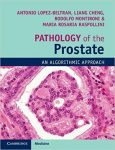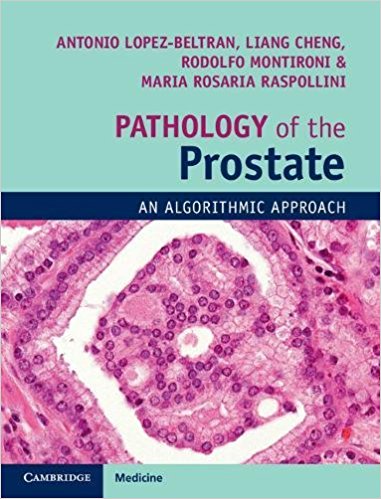 Authors: Antonio Lopez-Beltran, MD; Liang Cheng, MD; Maria Rosaria Raspollini, MD; and Rodolfo Montironi, MD
Authors: Antonio Lopez-Beltran, MD; Liang Cheng, MD; Maria Rosaria Raspollini, MD; and Rodolfo Montironi, MD
Publisher: Cambridge University Press – 215 pages
Book Review by: Nano Khilnani
Prostate cancer is the second leading cause of cancer deaths in men in the United States, after lung and bronchial cancer. Among all types of cancer in men and women, it is the fifth largest cancer killer. There were 161,360 new cases of prostate cancer diagnosed in 2017, according to the National Cancer Institute.
There were 26,730 people (old and new cases) who died from prostate cancer in 2017 in the U.S.
The prostate gland produces seminal fluid that transports the sperm. This organ is subject to an extraordinarily diverse array of diseases as well as abnormalities that are congenital, inflammatory, metaplastic, neoplastic, and non-neoplastic in nature.
This book aims to provide comprehensive, contemporary, and evidence-based information and guidance to medical oncologists, pathologists, and urologists. Up-to-date info0rmation on the pathology of prostatic urethra and seminal vesicles is also presented herein. Below is a list of the chapters of this book that serves to present to you an overview of the topics covered in it:
- Basic Anatomy and Histology of the Prostate
- Inflammatory and Tumor-Like Conditions of the Prostate
- Preneoplastic Lesions and Conditions of the Prostate
- Adenocarcinoma of the Prostate
- Gleason Grading of the Prostate
- Histologic Subtypes of Prostatic Carcinoma
- Neuroendocrime Tumors of the Prostate
- Pathologic Prognostic Factors of Prostate Cancer
- Pathology of the Prostate After Treatment
- Basic Molecular Pathology of Prostate Cancer
- Rare Forms of Prostatic Carcinomas
- Tumors and Tumor-Like Conditions of the Prostate Stroma
- Soft Tissue and Miscellaneous Primary Tumors of the Prostate
- Metastatic and Secondary Tumors of the Prostate
- The Seminal Vesicles and Ejaculatory Ducts
- Pathology of the Prostatic Urethra
- Practical Immunohistochemistry of Prostate Cancer and Related Lesions
You can find online resources at www.Cambridge.org/core, including fully searchable HTML text of the whole book, and expandable figures and tables. On the inside front cover of this book, scratch off the gray film to get the access code.
This book is a practical guide to prostate pathology. It is a structured text that helps both experienced practitioners as well as trainees in the diagnostic process. Numerous color images and algorithms show you how to integrate immunohistochemical and pathologic features to reach a correct diagnosis in prostate tumors and tumor-like lesions.
Among its important features are:
- Diagnostic challenges in day-to-day practice in misdiagnosis of tumor-like lesions
- Recent developments in biomarkers applied to immunohistochemistry
- Multidisciplinary approach to the clinical management of prostate cancer
An important part of this book is chapter 3 entitled Preneoplastic Lesions and Conditions of the Prostate because it gears your attention to the conditions that exist prior to the growth of neoplasms. This is a relatively short chapter but it provides numerous (40+) images that can be highly instructive in diagnoses. The following topics are discussed in this chapter:
3.1 – Prostatic Intraepithelial Neoplasia (PIN)
3.2 – Diagnostic Criteria for High Grade Prostatic Intraepithelial Neoplasia (HGPIN)
3.3 – Atypical Adenomatous Hyperplasia
3.4. – Post-Inflammatory Atrophy (PIA)
3.5 – Atypical Small Acinar Proliferation Suspicious for but Not Diagnostic of Malignancy
This is an important book on the prostate gland and its pathology. It is essential to those who are already involved in the treatment of patients with prostate cancer or of those who may be prone to developing it.
Authors:
Antonio Lopez-Beltran is Professor of Anatomic Pathology at Cordoba University Medical School and Director of Anatomic Pathology at Champalinaud Clinical Center. He is also Chairman of the European Working Group on Urologic Pathology and a member of the World Health Organization Expert Panel on urologic tumors along with Professor Cheng, Dr. Raspollini, and Professor Montironi
Liang Cheng is Professor of Pathology and Urology at the Indiana University School of Medicine, where his also Chief of the Genitourinary Pathology Service, Director of the Urologic Pathology Fellowship, and Director of Molecular Diagnostics and Molecular Pathology Laboratories.
Maria Rosaria Raspollini is consultant pathologist at the University Hospital Careggi, Florence, with expertise in gynecological and urological pathology and in the application of molecular techniques in uropathology.
Rodolfo Montironi is Professor of Pathology at the University of Arizona and Head of the Genitourinary Cancer Program at the Institute of Pathological Anatomy and Histopathology, Polytechnic University of the Marche Region (Arizona) School of Medicine, United Hospitals. He is also Chairman of the ESUP, a full section of the European Association of Urology devoted to Urologic Pathology.







